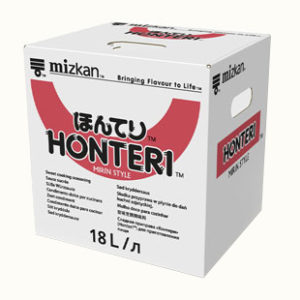6th September, 2021
What is Mirin?
Mirin is a naturally fermented Japanese sweet rice wine popular within Japanese cuisine. This clear, gold liquid is an essential in many dishes such as chicken teriyaki, ramen and udon.
The condiment is similar to sake – what differentiates the two is that mirin has more sugar and it’s mainly used for cooking, unlike sake which is also enjoyed as a drink.
Whilst it does taste a little like sake, mirin has a complex flavour of sweetness, a subtle tang yet quite a rich flavour, resulting in a lot of umami undertones balanced by mild acidity.
This blog post will help chefs understand the different types of mirin, what it’s made of, its uses and how chefs can use the condiment to experiment and add their own special touch to a range of Japanese dishes.

Different Types of Mirin
Mirin can come in three different types, from its purest, most authentic form to variations. Let’s explore them further:
What is Mirin Made of?
The three main pure mirin ingredients are rice, rice koji and shochu. The product is fermented from 2 months to up to several years.
Authentic mirin’s sugar is generated naturally during fermentation. Other mirin-like condiments, however, may contain artificial sweeteners.
What is Mirin Used for?
Due to its umami flavour, mirin is known to complement soy sauce in many Japanese dishes and is part of many traditional sauces such as teriyaki sauce, ponzu sauce and tempura dipping sauce.
Let’s explore what else the condiment is used for:
Best Mirin-Style Seasoning

It’s generally very hard to achieve the exact flavour given by mirin through any other condiments. However, Mizkan Chef’s Honteri, a mirin-style sweet seasoning, is a high-quality product the same as mirin but with less than 0.5% alcohol content.
It contains glucose syrup, water, spirit vinegar, fermented rice alcohol, sugar and acidity regulators citric acid and cane molasses. Just like mirin, Honteri brings a unique sweetness and depth of flavour to many dishes, as well as giving them a glossy shine.
Unlike mirin, however, which must be boiled to evaporate the alcohol, Honteri contains almost no alcohol and can be used untreated so you can achieve the same complex flavour with less effort and smaller amounts.
Honteri Mirin-style Recipes
There are endless possibilities for using Honteri in Japanese and fusion dishes such as making ramen or udon noodle dishes, yakitori, marinades, salad dressings and desserts.
We have a variety of exciting dishes that contain Honteri on our recipes page – from vegetarian dishes such as agedashi tomato to meat dishes like Japanese-style turkey hambaagu.
It can also be used in drinks such as Mulled Honteri and desserts like chocolate miso cake.
For chefs looking to learn more about our high quality Honteri mirin-style seasoning and how they can purchase it for their restaurants, please get in touch with us or sign up to our newsletter for all the latest news, recipes and trends within the Japanese foodservice industry.

